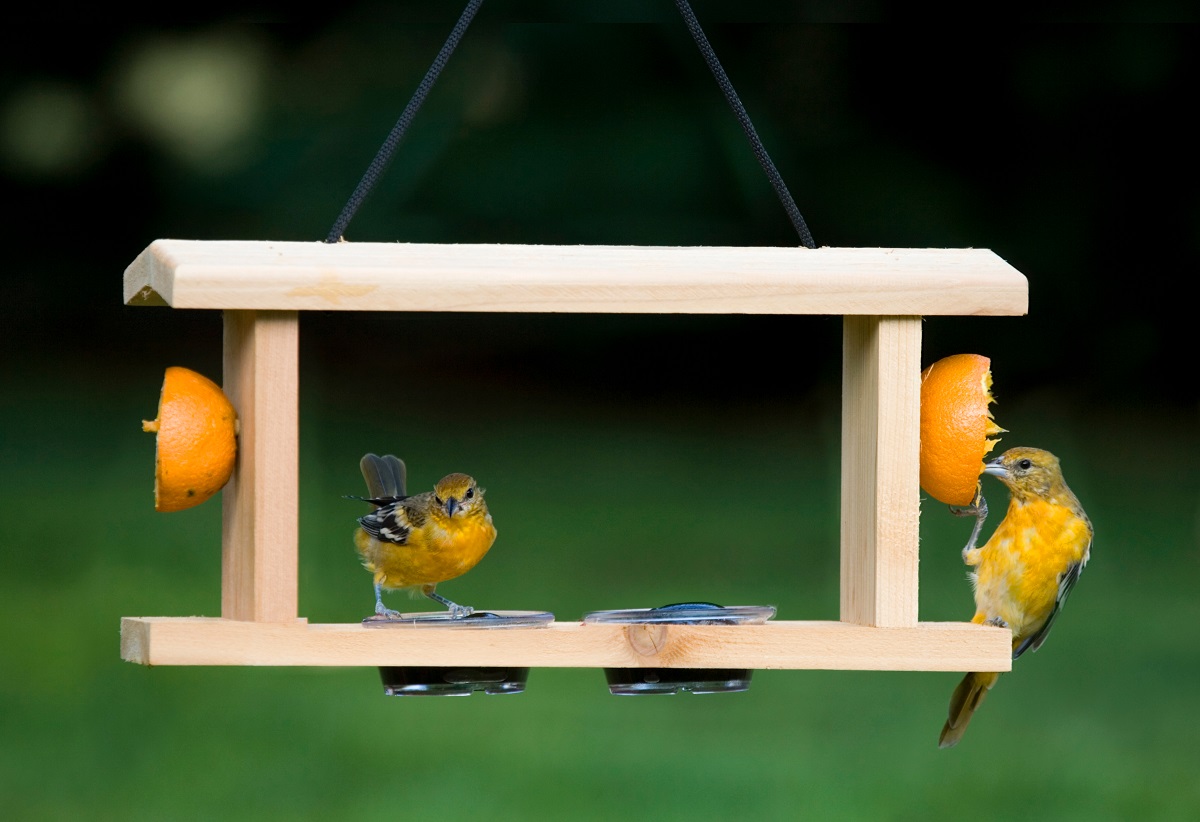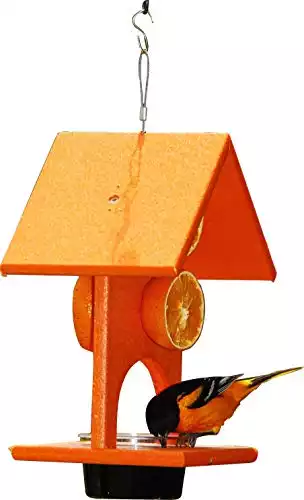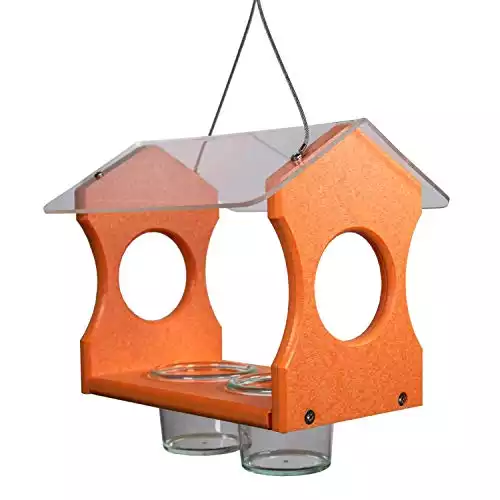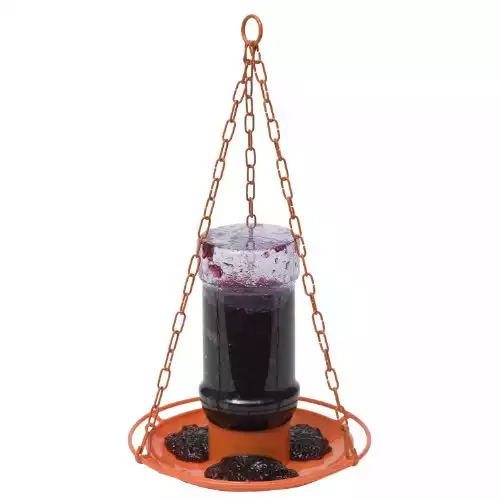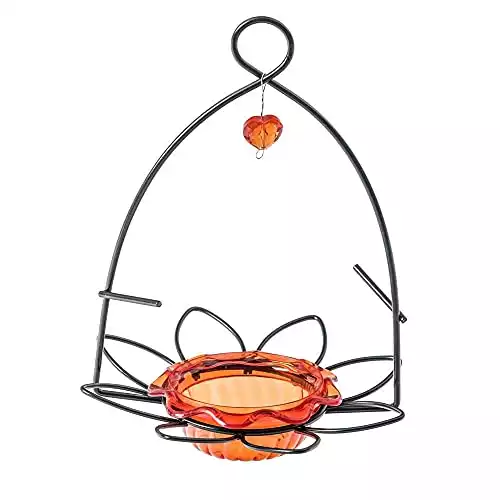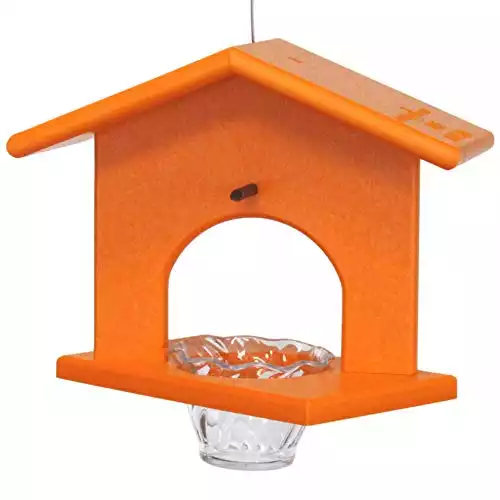To attract orioles to your backyard, a bird feeder that serves fruit and jelly or suet will do the job. They don’t like seed, so a classic seed feeder just won't do for these fruit-loving songbirds. If you can't afford yet another bird feeder, making an eco-friendly oriole feeder is easy.
Orioles are attracted to fruit and love the color orange. If you want to draw these delightful backyard birds to your yard, knowing what they like to eat is critical. In the wild, they dine on insects in the summertime and switch to fresh fruit, berries, and nectar in cooler months.
Since orioles don’t like traditional birdseed, you need an oriole feeder built to supply jelly, jams, and fresh fruit.
You can pick one featured on our list below or make your own at home.
Oriole Feeders – Comparison Table
| Product Image | Product Name / Primary Rating / Pros | Primary Button |
|---|---|---|
|
||
|
||
|
||
|
||
|
- Fruit and jelly feeding options
- Environmentally friendly
- Durable and long-lasting
- Excellent craftsmanship
- Weather resistant
- The design allows orioles to fly right through it
- Large circular feeding tray
- Can accommodate its own jelly container and store-bought jelly jars
- Visually attractive to orioles
- Ability to dispense jelly, fruit, or nectar
- Ample feeding capacity
- Local craftmanship
- Handcrafted quality
- Jelly dish and pegs for orange halves
- Ready-to-hang design
Our Top 5 Picks in Detail
1. Songbird Essentials Fruit and Jelly Oriole Feeder
- Made from recycled material
- Dual feeding options
- Easy to fill and clean
- Long-lasting color
- Hanging cable
The Songbird Essentials oriole feeder offers several features designed to attract and provide food for orioles.
The feeder is proudly manufactured in the United States. The feeder is constructed using recycled materials, which can contribute to environmental sustainability.
This feeder is designed to accommodate both orange halves and jelly. It holds 4 orange slices and features a large glass bowl for holding jelly, making it accessible for orioles to feed from.
The feeder’s bright orange color is designed not to peel or fade over time. This ensures that you can enjoy watching orioles return to the feeder year after year.
It comes with a hanging cable to secure the feeder to a branch, hook, pole, or other suitable location.
Pros
- The combination of fruit and jelly feeding options encourages frequent returns
- Environmentally friendly
- Durable and long-lasting
Cons
- Some users might experience issues with certain components, such as cups or bowls, being brittle or fragile
2. JCs Wildlife Poly Lumber Orange Oriole Bird Feeder
- Durable construction
- Built-in roof
- Hanging design
- Plastic jelly jars
- Open concept design
- Made in the USA
The feeder is constructed using durable recycled poly lumber, which is made from recycled plastic milk jugs. This eco-friendly choice is not only durable but also easy to clean and care for.
The feeder features a see-through acrylic roof that serves multiple purposes. It helps keep water out of the jelly cups during rainy days and provides a sheltered area for orioles during inclement weather.
It comes with 2 plastic feeding cups that can each hold about 0.5 cup of grape jelly, a favorite food of orioles.
It comes with an attached hanging cable, making it easy to suspend the feeder from tree branches, hooks, or other suitable locations in your garden.
The feeder is proudly made in Southern Indiana, USA, by JCs Wildlife, a company known for its innovation in the outdoor birding and wildlife industry.
Pros
- Local manufacturing and excellent craftsmanship
- The feeder’s construction materials, including plexiglass and stainless steel screws, is great for weather resistance
- The design allows orioles to fly right through it, creating a setup that encourages easy access for these birds to feed
Cons
- The jelly containers are a little bit deeper which may cause problems when the containers are not fully filled
3. Perky-Pet Wild Oriole Jelly Bird Feeder
- Large feeding tray
- Wraparound perch
- Built-in stirrer
- Versatile jelly container
- Jelly protection
- Large jelly capacity
The feeder is specifically designed to attract orioles by offering grape jelly, one of their favorite sweet treats. The bright orange tray also serves as an additional attraction for orioles.
The feeder features a large circular feeding tray with a wraparound perch. This design provides ample space for multiple orioles to feed simultaneously. It’s also equipped with a built-in stirrer on the base. This feature helps distribute the perfect amount of jelly into the feeding tray every time you refill the feeder.
The feeder is designed to fit most store-bought jelly jars with 2.5″ openings. This provides flexibility in the types of jelly containers you can use. It comes with an inverted jelly jar to protect the jelly from the elements. This design helps keep the jelly fresh and dry, extending its longevity.
The included jar has a capacity of up to 32 oz of grape jelly. This allows for extended feeding times before needing to refill.
Pros
- The large circular feeding tray with a wraparound perch can accommodate multiple orioles at the same time
- The feeder can accommodate both its own jelly container and store-bought jelly jars
- The bright orange tray serves as an attractive visual element that not only attracts orioles but also adds a vibrant touch to the yard or garden
Cons
- If the feeder is not properly fastened, it often leads to tipping or flipping over
4. Birds Choice OFF Oriole Flower-Shaped Feeder
- Durable construction
- Dual function oriole feeder
- Orange ornamental heart jewel
- Versatile food dispensing
- Hanging mount
The feeder is constructed using durable polycarbonate and black powder-coated steel, which ensures a long-lasting life and withstands outdoor conditions.
The feeder is suitable for dispensing various types of food that orioles enjoy, including jelly, fruit, or nectar. It’s designed to attract orioles with its bright orange color.
It allows you to place orange halves on two pegs above the cup and fill the jelly cup with food that orioles love. The presence of the orange ornamental heart jewel adds an aesthetic touch.
The feeder has a capacity of 3 oz, allowing you to provide a sufficient amount of food for visiting orioles.
The feeder also includes an orange ornamental heart jewel, adding to the visual appeal of the feeder and potentially attracting orioles with its bright color.
Pros
- The ability to dispense jelly, fruit, or nectar is a versatile feature
- Ample feeding capacity
- Users who value supporting local manufacturing might appreciate knowing that the feeder is made in a facility in Chilton, WI
Cons
- Users might encounter challenges with the feeder’s stability, especially in windy conditions
5. Amish Toy Box Oriole Bird Feeder
- Handcrafted by Amish artisans
- Eco-friendly materials
- Hanging loop design
- Plastic dish for jelly
- Aesthetic value
- Color options
The Amish Toy Box Oriole Bird Feeder offers a combination of functionality and aesthetics to attract and feed orioles in your garden.
This feeder is made by Amish artisans in Shipshewana, Indiana, with a focus on craftsmanship and attention to detail.
It’s constructed from Poly-Wood, a material made from recycled milk jugs. This eco-friendly choice aligns with sustainability practices.
The feeder comes equipped with a jelly dish for holding grape jelly or other treats that orioles enjoy. It also features pegs for placing orange halves, which are a favorite food source for orioles.
The feeder comes ready to hang with a cable and ring, making it easy to suspend in your desired location.
In addition to its functionality, the feeder is designed to be a lovely garden decoration, adding visual appeal to your outdoor space.
Pros
- Handcrafted quality
- The inclusion of both a jelly dish and pegs for orange halves provides users with flexibility in offering different types of food
- Ready-to-hang design
Cons
- Swings around when multiple birds land on it
What are the best feeders for orioles?
The best feeders for orioles are designed to attract these vibrant and unique birds while providing them with the foods they love, such as nectar, fruit, and jelly.
Here are some popular types of oriole feeders that are commonly recommended:
Oriole Nectar Feeders: These feeders have specially designed ports for offering nectar, which is a favorite of orioles. Nectar can be made by mixing water and sugar. Look for feeders with bright colors (such as orange or red) to attract orioles.
Fruit Feeders: Orioles are also attracted to pieces of fresh fruit, especially oranges. Some feeders have pegs or spikes where you can place orange halves. Orioles will feed on the fruit juices.
Jelly Feeders: Orioles are known to enjoy grape jelly. Jelly feeders have shallow cups where you can place the jelly. Look for feeders with covers or roofs to protect the jelly from rain and other elements.
Combo Feeders: These feeders combine multiple feeding options, such as nectar ports, fruit pegs, and jelly cups, to provide a variety of choices for orioles.
When choosing an oriole feeder, consider factors like the feeder’s capacity, ease of cleaning and refilling, durability, and the specific types of food it can accommodate.
Keep in mind that different oriole species might have slightly different preferences, so having a variety of offerings can help attract a wider range of these beautiful birds to your yard.
Watch our video and learn 7 things about orioles you may not have known about!
Where should oriole feeders be placed?
- Near Trees or Shrubs: Orioles are known to perch in trees and shrubs while they assess their surroundings and look for food. Place the feeder within 10 to 15 feet of trees or shrubs to provide perching spots for orioles to rest between feedings.
- Partially Shaded Area: Orioles prefer feeders that are placed in areas with some shade. This helps keep the nectar, fruit, and jelly from spoiling quickly due to direct sunlight and high temperatures.
- Away from Busy Areas: Try to place the feeder away from high-traffic areas where people and pets might disturb the birds while they’re feeding. This can help orioles feel more comfortable and secure.
- Visible from Indoors: Position the feeder in a location where you can easily see it from indoors, such as near a window. This way, you can enjoy watching the orioles without disturbing them.
- Height: Hang the feeder at a height that allows easy access for orioles to perch and feed. A height of around 5 to 6 feet from the ground is generally suitable.
- Protection from Wind: Avoid placing the feeder in an area that’s too exposed to strong winds, as this can make it difficult for orioles to feed comfortably.
- Covered Area: If possible, position the feeder under an overhang or near the edge of a porch or roof. This provides protection from rain and keeps the food dry.
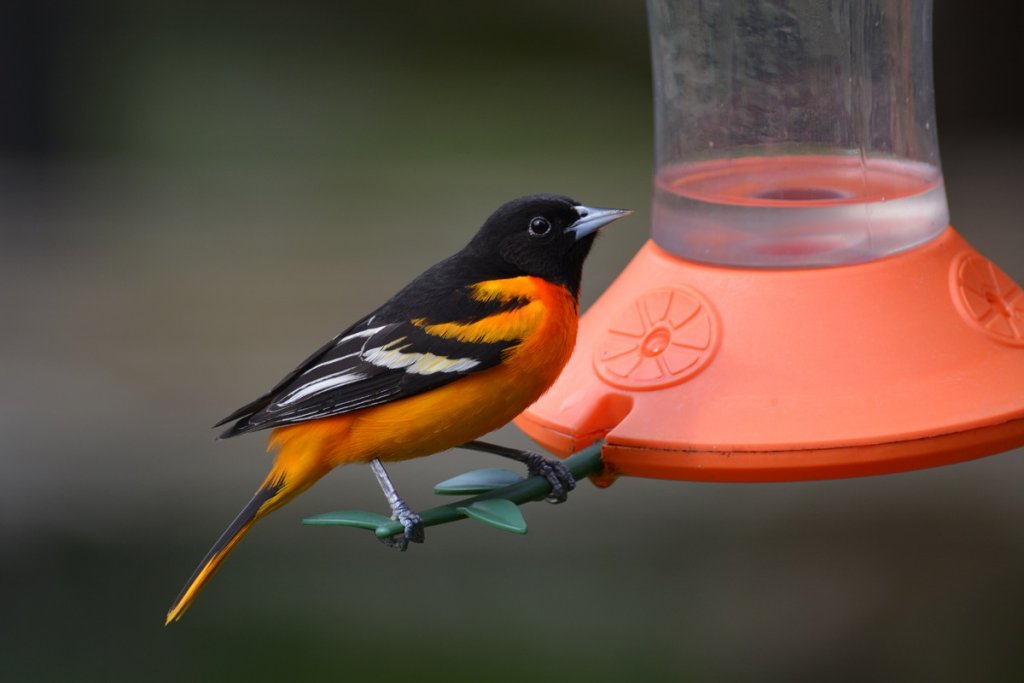
Do orioles eat from hummingbird feeders?
Yes, orioles are known to occasionally visit hummingbird feeders and feed on the sugary nectar they provide. While orioles have slightly different feeding preferences than hummingbirds, both birds are attracted to sweet fluids.
Oriole nectar feeders are designed to accommodate the larger size and feeding habits of orioles, with larger perches and ports.
What should you feed orioles?
Orioles have a diverse diet that includes nectar, fruit, and insects. To attract orioles to your yard and provide them with the right nutrition, you can offer a variety of foods:
- Nectar: Orioles are attracted to sweet nectar. You can prepare a simple nectar solution by mixing 1 part white granulated sugar with 4 parts water. Boil the water to remove impurities, then let it cool before filling your oriole nectar feeder. Avoid using red food coloring or honey, as they can be harmful to birds.
- Fruit: Orioles love fresh fruit, especially citrus fruits like oranges and grapefruits. Cut the fruit in halves and place them on pegs or spikes on a feeder designed for fruit. The bright colors of the fruit will attract orioles.
- Jelly: Grape jelly is a favorite treat for orioles, especially during the nesting season when they need extra energy. Offer small amounts of grape jelly in a shallow dish or cup on an oriole feeder.
- Insects: Orioles also consume insects and spiders, which provide essential protein for them and their nestlings. Planting native plants that attract insects can help provide a natural food source for orioles.
- Suet: Some orioles might also eat suet, especially during colder months when insects are less abundant. Use specially formulated oriole suet cakes.
- Flowers: Planting flowers that produce nectar, such as trumpet vines, bee balm, and milkweed, can attract orioles by providing a natural food source.
What is the best way to attract orioles to a feeder?
Attracting orioles to your feeder requires a combination of offering the right foods, creating an inviting environment, and ensuring the feeder is easily accessible for these colorful birds.
Here are some effective tips to attract orioles to your feeder:
✔ Choose the Right Foods: Offer a variety of foods that orioles enjoy, including nectar, fruit, and jelly.
✔ Use Bright Colors: Orioles are attracted to bright colors like orange and red. Choose feeders that have these colors, and consider placing orange slices or other colorful decorations near the feeder.
✔ Place Feeders at the Right Height: Hang oriole feeders at a height of about 5 to 6 feet from the ground. This allows orioles to access the feeders comfortably.
✔ Create Shelter: Position feeders near trees, shrubs, or other natural vegetation that can provide shelter and perching spots for orioles to rest between feedings.
✔ Offer Fresh Water: Orioles need water for drinking and bathing. Providing a shallow birdbath near the feeders can attract them to your yard.
✔ Use Multiple Feeders: Offer a variety of feeders with different food types to cater to different oriole preferences.
✔ Be Patient: It might take time for orioles to discover your feeders, especially if they’re newly placed. Be patient and give them time to find the food source.
✔ Maintain Clean Feeders: Regularly clean and refill the feeders to ensure the food is fresh and appealing to orioles.
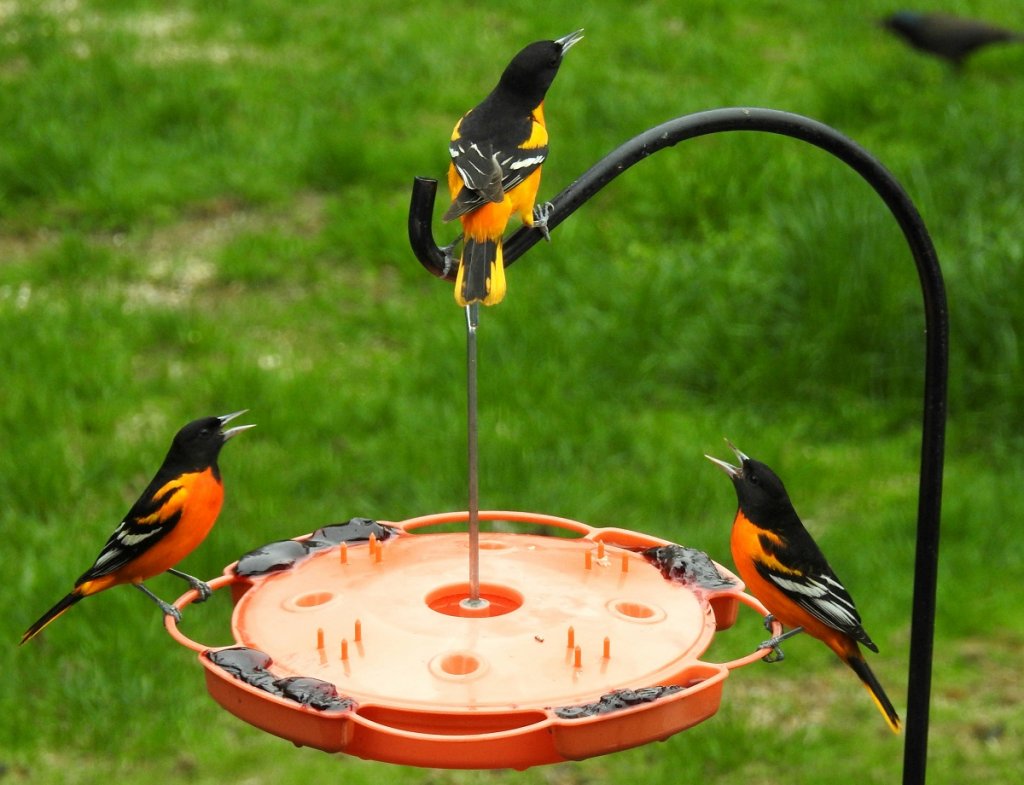
How to Make a DIY Homemade Oriole Feeder
Homemade feeders are a great eco-friendly way to repurpose old items like bottles, wire, poly lumber, and even old jelly jars.
- Old Juice Bottle Feeder. Do you have an extra plastic juice container and some BBQ skewers lying around? Cut a large opening on both sides of the juice bottle, and place jelly and hole for skewers that work as perches. At the top, place another set of skewers through the top of the bottle, and hang orange halves at the top.
- Deli Cup Feeder. While a deli cup is a perfect size for grape jelly, any bowl or plastic container works in a pinch. Using metal wire, fasten the wire securely around a deli container filled with jelly, and hang it from a nearby tree.
- Super Simple Orange Slice Feeder. This method is perfect if you aren’t too handy or crafty. Orioles will come by simply cutting an orange in half and impaling it on a nearby tree branch. It’s not the most elegant solution, but it’s perfect if you are on a budget and aren’t too crafty.
What to read next: What Do Orioles Sound Like?

